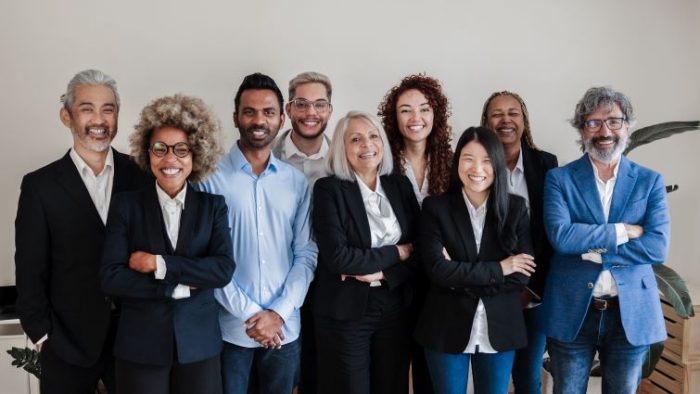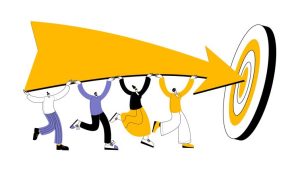How To Manage A Multi-Generational Workforce
 Publié le 20 November 2023
Publié le 20 November 2023
Business leaders need to make an active effort to learn how to manage a multi-generational workforce that will lead to growth and success.
Maintaining a multi-generational workforce has lots of benefits. Just like other types of diversity, having people from all walks of life in the workplace makes teams much more effective. Harmful stereotypes about every generation abound in the media (and even in the office). These do little to help us see clearly or make the most out of our skilled workforce.
In order to understand how to manage a multi-generational workforce, managers need to learn about any possible differences between generations and how to promote collaboration, understanding and respect. With that in mind, let’s explore a method to help you build a team that thrives.
Three Challenges Of A Multigenerational Team
Image sourced from knoema.com
In this section, we will cover three core challenges that arise when you’re managing a multigenerational workforce of baby boomers, generation z, and everything in between. While differing personalities, expectations, and behaviors can challenge any team, a multigenerational team adds a unique twist to the mix.
1. Differing expectations
Balancing expectations is one of the main challenges of maintaining a multi-generational workforce. Each generation grows up with a different set of norms and expectations. Dress codes are no longer as strict or as formal, for example. Younger generations tend to have a much more relaxed approach to clothing at work.
There is also a contrast in how some generations approach timetabling. Some generations feel pressure to stay longer at the office and call track every day, and others demand a fair work-life balance. There must be a way to promote hard work and collaboration with a workplace team, with the support to take needed time with family and friends.
2. Harmful stereotyping
The world and media are awash with harmful stereotypes about every generation, and frankly, they are nothing new.
There’s an ingrained idea that older generations, dubbed — “baby boomers’” — are out of touch and unable to adapt to new workplace initiatives such as virtual reality training. Gen Zers on the other hand, are often seen as lazy and having a poor work ethic.
Despite clear evidence that these generational stereotypes are untrue, they still persist. Unfortunately, these biases can become unconscious where they influence both how we perceive those around us and how we believe we are being perceived.
3. Finally, discrimination
The above undoubtedly leads to discrimination – believing that one person has a lower value than another is a quick road to instilling bigoted policies. Discrimination is about more than unconscious beliefs or lazy stereotypes. It’s about real-world policies and differences in pay and treatment at work.
Discrimination on the basis of age can occur at all stages of work life, from who gets hired, to how much they get paid, opportunities (or lack thereof) for development and promotion, and even turnover.
While most people expect to earn more the longer they spend at a company, paying people less than the average on the basis of their age could be discriminatory.
Younger people are often expected to work unpaid overtime because they need to “do their dues”, whilst older generations are asked to do so in order to “prove that the company needs them”. Both instances are incredibly problematic and have no place in the modern workplace.
Of course, age discrimination can also take the form of hurtful jokes or comments about age, even when these are meant in jest.
Four Benefits of a Multigenerational Team
Image sourced from aarpinternational.org
Now that we’ve covered the main challenges that face multi-generational workforces let’s delve into the pretty significant benefits.
1. A wider range of skills and knowledge
It’s a cliche, but it’s true. Older people are likely to have more experience and knowledge of the world from the sheer force of having been around for longer.
They may also be knowledgeable in older ways of doing things that can help decrease an overreliance on new technologies such as video technology. Younger colleagues are likely to have been in education more recently and, as such, have more knowledge about the most recent techniques and technology, as well as a fresh pair of eyes in the industry.
A multigenerational workforce enjoys a much wider range of education and experience than a single-generation team.
2. Improved customer service
Unsurprisingly, a diverse workforce is better suited to serving a diverse community. A multigenerational team can make your company more attractive to customers of different ages. Feeling understood and seen is so vital to customers. There’s no better way of delivering this than with a diverse customer service team.
3. Mutual learning
As well as bringing different strengths to the table, a multigenerational team can also learn from itself. Team members can learn from each other in a myriad of ways. When working optimally, team members are able to learn from each other’s strengths.
Experienced members can lean on their experiences to provide career advice, mentoring, and insights into the company and the industry, as well as any relevant technical guidance.
Newer team members can bring a fresh perspective, new approaches, as well as recent insights into current developments and ideas in the industry.
4. Different approaches to challenges
Different ages bring different things to the table. Older colleagues may have experienced more instances of interpersonal conflict and learned how to navigate these with greater ease than their younger counterparts. However, they may hold unintentional biases formed from these experiences also (not that this is a unique feature of older colleagues).
Younger team members may be more adaptable in the face of challenges, such as using the new legacy modernization mainframe, since they won’t have as entrenched a blueprint for how to interact as their older colleagues. However, they may lack the confidence that comes with experience.
Age-diverse teams are great for pushing people out of their comfort zones and considering new ways of approaching and tackling challenges.
Finally, both younger and older can experience their assumptions and internalized biases come to a screeching halt. Mutual respect and admiration is the inevitable consequence of a multi-generational team working harmoniously together.
Techniques For Managing A Multigenerational Workforce
If you want to overcome all of the challenges that come with managing a multi-generational workforce and experience all of the significant benefits of diversity of experience, then read on.
1. Hire managers who care about diversity
It’s essential that you hire managers who care about diversity. Change often starts from the top, and by choosing people who will have the right attitudes and can set a positive example for their team, you will have won half the battle.
When promoting someone from your existing team, choose somebody with a strong work ethic and stellar interpersonal skills who treats everyone with incredible respect. When hiring externally, carefully screen them with help from your candidate information system to weed out anyone with glaring biases.
2. Diversity training is key
Diversity training is a key component of building a multi-generational workforce. Training makes your values as an organization clear and gets issues out in the open so people can become aware of their own biases and challenge them.
Diversity training should also give people a clear idea about how they can respond and what actions they are able to take to combat any discrimination in the office.
In relation to age, diversity training should cover different types of discrimination, as well as the consequences on staff, including financial, emotional, social, etc. Including statistics about the benefits of working in a multi-generational workforce is helpful, as well as conducting team-building exercises and smaller group discussions.
3. Make space for different communication styles
Some people like to use emojis to clarify the tone of their message, others prefer to use just plain text. As a manager, it’s important to make space for people to feel that they can express themselves freely (within reason) without having to massively change how they communicate.
There are both personal differences and differences more dictated by age. If someone prefers to email rather than phone, that’s okay. If somebody else prefers written memos, hand-delivered to everyone’s desk, that’s also okay.
However, if you as a manager have a strong preference for one type of communication over another, offer some guidance to help your employees out on the subject of corporate communication. You can include rules about signatures or how to address customers, for example. Just don’t micromanage, people do best when they’re allowed to be themselves.
Image sourced from statista.com
4. Check for age discrimination
Discrimination isn’t always obvious or intentional. You could inadvertently have age-discriminating language in a wide range of places, including your job adverts, or policies that accidentally discriminate against some age groups. Do your ads frequently ask for “recent graduates”? Or do they insist on at least 10 years’ of experience for a bottom-level position?
You can audit your workforce metrics to figure out whether younger and older workers are being hired, paid, and promoted at the same rate as each other. Services like diversity recruiting Oleeo can help you if you find patterns that correlate with age rather than ability.
5. Offer flexible benefits
The needs of a 25-year-old are not the same as a 35-year-old, which are not the same as a 45-year-old, and so on. Your employees’ needs change as they age, and the benefits that come with working for you should reflect this. You can tailor your benefits to accommodate the needs of your employees throughout their lives, whether it’s taking care of their career development, or flexible work hours.
Make having open discussions with your employees, preferably one-on-one, a priority. This will help you to know team members better and improve job satisfaction. Perhaps you need to implement some new HR practices for remote workers.
Consider implementing virtual team building activities that can help to bridge generational gaps and foster stronger connections among team members.
You can also have a pick-and-mix system where folks can assemble a series of benefits from a predetermined set to best meet their personal needs.
Final Thoughts
Having a multi-generational workforce is something to take pride in; Diversity has been shown to enhance companies. If you can manage different needs on the basis of age effectively, as well as combat discrimination toward the silent generation, the boomer generation, millennial employees, and beyond, you are in for a very healthy workforce.







